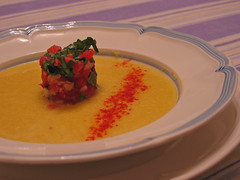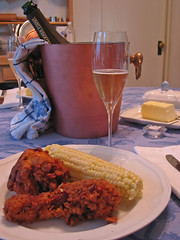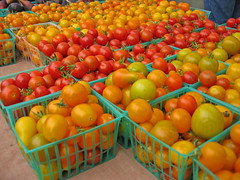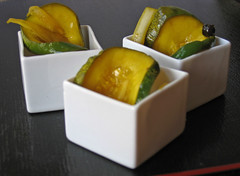Within two days of each other, Amy and Pim tagged me for the "cook next door" meme going around. I have to do it now: I'm likely to run into them at local food blog events!
Though this wandering post provides glimpses into food bloggers' pasts, the most interesting aspect is the map that Nicky has meticulously maintained. I look forward to seeing how she maps the two lines that come into this post.
What is your first memory of baking/cooking on your own?
When I was about nine or ten, my dad set up a schedule that had a different person in charge of breakfast for a week at a time every day. I don't think cereal was allowed, and I would often make muffins. Some things I learned: baking powder is actually a good idea; also, if you want a little dollop of jam in the middle of a muffin, don't mix the jam into the batter.
Who had the most influence on your cooking?
I've had a number of influences. My mom is the one known for fancy food clipped from Bon Appétit or Gourmet, but my dad is one of those people who can assemble good food from seemingly disconnected ingredients in the fridge. I'm somewhere in between: comfortable with the fancy stuff, but able to work with odds and ends. Tom Dowdy has inspired me to push myself and learn more. The multi-course dinner parties we're known for arose immediately after we ate at The French Laundry, so I'd list Thomas Keller as an influence.
Do you have an old photo as 'evidence' of an early exposure to the culinary world and would you like to share it?
Sigh. Yes. I was going to say no, but Melissa insisted on taking pictures of these old prints we have. She collected them (unbeknownst to me) before the wedding to assemble into a booklet.

Melissa saw this picture and started laughing:I still use the exact same pose when using my Kitchen-Aid. Except, you know, my head's higher up.

Putting the thumb in thumbprint cookies. Look how much I'm smashing the cookies! The edges are totally messed up!

Putting the cookies in the oven. Note how my mom has let me do this without any potholders. We decided not to include the picture of me in tears with a big burn on my hands. (Just kidding)
Mageiricophobia - do you suffer from any cooking phobia, a dish that makes your palms sweat?
Not that I can think of. I'll make anything that strikes my fancy (and sometimes force others to do the same).
What would be your most valued or used kitchen gadgets and/or what was the biggest let down?
The successes:
- My seven Mauviel copper pots (which Melissa polished for our anniversary).
- Tongs
- Whisk
- And, you know, some good knives
The failures:
- Those little rubber garlic peelers. Much easier to use a knife.
- Food processor - I use mine for just a few things. For everything else, it cuts way too unevenly.
Name some funny or weird food combinations/dishes you really like - and probably no one else!
Melissa's response: "Is there anything weirder than the fact that you like Mountain Dew?"
What are the three eatables or dishes you simply don't want to live without?
Duck fat. Wine. Snickerdoodles. But not mixed together.
Your favorite ice-cream...
Mint chip.
You will probably never eat...
I'm with Adam. Count me out on dead babies.
Your own signature dish...
When Melissa and I started dating, it was risotto. I now make a much better risotto, but lots of people request my chocolate truffles. I wouldn't say I have a signature dish, but that's probably the closest.
A common ingredient you just can't bring yourself to stomach...
Something I can't stomach? There are things I don't like, but I'll eat them, and sometimes I'll realize that my tastes have changed.
Which one culture's food would you most like to sample on its home turf?
Everyone's.
The people I am tagging are:
As Jennifer said, if you want to play, write me. Tse Wei did, and you could too!














